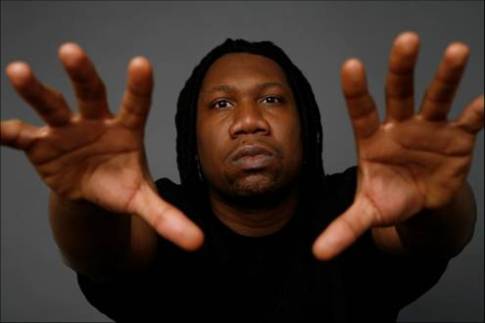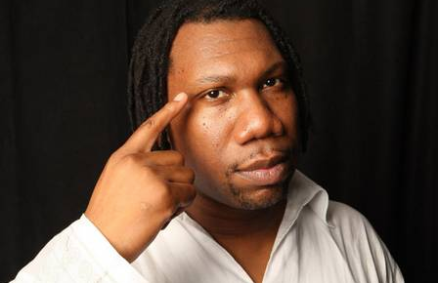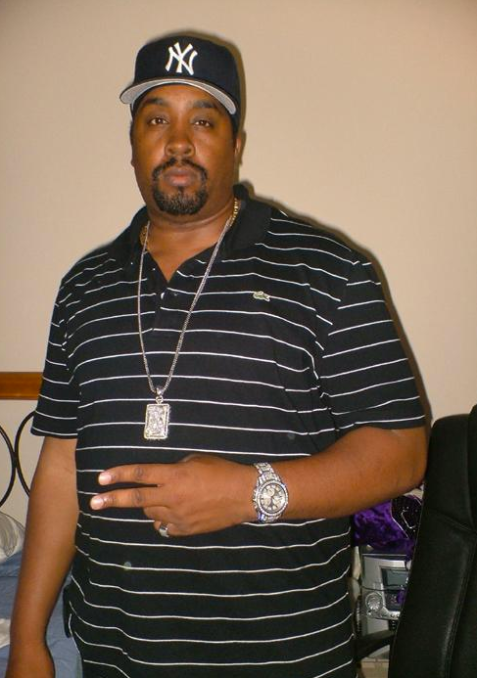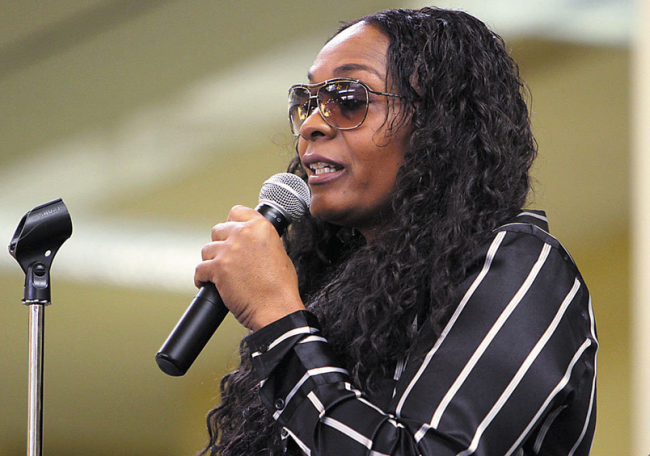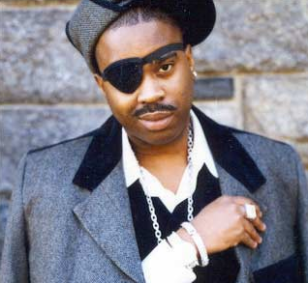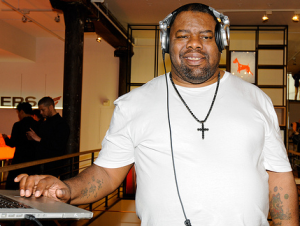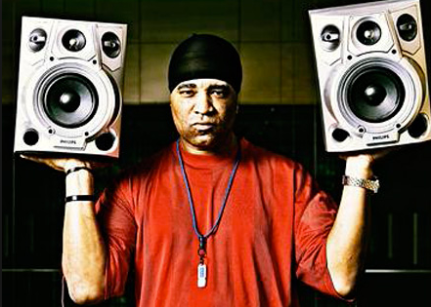 LL Cool J – short for “Ladies Love Cool James” – was born in 1968 in Long Island, New York, and grew up in Queens. He started rapping aged nine, and music provided a way to escape the suffering he endured. He had a tough childhood because his parents had a violent relationship. His father shot his mother and grandfather with a 12-gauge shotgun, in front of him, when he was four years old. Both survived, and in the hospital his mom met her second husband who was just as abusive. He frequently abused LL mentally and physically while his mom left home to work. “Roscoe’s constant beating changed me, I went from this normal kid who got straight A’s and loved school to a troublemaker.” wrote LL in his biography.
LL Cool J – short for “Ladies Love Cool James” – was born in 1968 in Long Island, New York, and grew up in Queens. He started rapping aged nine, and music provided a way to escape the suffering he endured. He had a tough childhood because his parents had a violent relationship. His father shot his mother and grandfather with a 12-gauge shotgun, in front of him, when he was four years old. Both survived, and in the hospital his mom met her second husband who was just as abusive. He frequently abused LL mentally and physically while his mom left home to work. “Roscoe’s constant beating changed me, I went from this normal kid who got straight A’s and loved school to a troublemaker.” wrote LL in his biography.
His grandfather who was a jazz saxaphonist, bought him $2000 worth of equipment including two turntables, an amplifier and a mixer which helped him get into making music. LL said “By the time I got that equipment, I was already a rapper. In this neighborhood, the kids grow up in rap. It’s like speaking Spanish if you grow up in an all-Spanish house. I got into it when I was about 9, and since then all I wanted was to make a record and hear it on the radio.” He developed a demo tape and aged just 16, signed to Def Jam, a new label set up in 1984 by Russell Simmons and Rick Rubin.
LL’s and Def Jam’s first single was “I Need A Beat” and it was an underground hit, selling 100,000 records:
The commercial success of “I Need a Beat”, along with the Beastie Boys’ single “Rock Hard”, helped lead Def Jam to establish itself and get a distribution deal with Columbia Records in 1985.
“Radio”
LL left school and recorded his first album, “Radio” which was “a hugely successful mix of conventional song structure and pop-oriented rap.” according to Biography.com. The album’s singles included:
“I Can’t Live Without My Radio”:
and “Rock the Bells” was also a single from the album “Radio”:
Wikipedia explains “The album was primarily produced by Rick Rubin, who provided a sparse and minimal production style. “Radio” also features a sound that is punctuated by DJ scratching, mostly brief samples, and emphasis of the downbeat. LL Cool J’s b-boy lyricism conveys themes of inncer city culture, teenage promiscuity, and braggadocio raps.
LL’s DJ on the album was Cut Creator. A Queens native and former trombonist, he met LL at a block party and they began performing together. LL also had another DJ, Bobcat.
“Reflecting the new school and ghettoblaster subculture in the U.S. during the mid-1980s, Radio belongs to a pivotal moment in the history and culture of Hip Hop. Its success contributed to the displacement of the old school with the new school form and to the genre’s mainstream success during the period. Its success also served as a career breakthrough for LL Cool J and Rick Rubin. “Radio” has been recognized by music writers as one of the first cohesive and commercially successful Hip Hop albums.”
New School v. Old School
“The new school started in 1983-84 and was initially characterized in form by drum machine led minimalism, often tinged with elements of rock. It was notable for taunts and boasts about rapping, and socio-political commentary, both delivered in an aggressive, self-assertive style. In image as in song its artists projected a tough, cool, street b-boy attitude. These elements contrasted sharply with the funk and disco influenced outfits, novelty hits, live bands, synthesizers and party rhymes of artists prevalent in 1984, and rendered them old school. New school artists made shorter songs that could more easily gain radio play, and more cohesive LPs than their old school counterparts. By 1986 their releases began to establish the Hip Hop album as a fixture of the mainstream.”
The album “Radio” sold 500,000 copies in its first five months and went on to go platinum. It entered the Top R&B/Hip-Hop Albums chart in December 1985, and remained there for forty-seven weeks, while also entering the Pop Albums chart for thirty-eight weeks in January 1986. Critics regard it as LL’s greatest work and it ranks in many lists of the best albums / best Hip Hop albums / best Rock albums of all time.
An iTunes reviewer has said of its sound, “Rubin’s production combined the sonic economy of punk rock with the malevolent bellow of a tricked out ghetto blaster, providing the sonic blueprint for an entire generation of Hip Hop producers”.
“Bigger and Deffer”
“Bigger and Deffer” was LL’s second album, released in 1987. It sold 3 million records in the U.S. alone and was at #1 for 11 weeks on the Billboard R&B chart. DJ Pooh produced this album.
“I’m Bad” was a single from the album (original video):
“I Need Love” was revolutionary as it is considered the first Hip Hop love ballad. Wikipedia notes that “It was not the first rap love song, however; in 1982 the Sugarhill Gang had recorded “The Lover in You”, which reached Number 55 on the R&B charts.) The drums were played with a Roland TR-808 and the keyboard tone was played with a Yamaha DX7.
“I Need Love”:
“Go Cut Creator Go” was another single featuring his DJ:
“Walking With a Panther”
“Walking With a Panther” was LL’s third album, released in 1989.
“Jingling Baby” was a single from the album (original video):
“Going Back to Cali” was also a single from the album.
“Going Back to Cali” (original video):
Criticism
“The “Walking With a Panther” album however was often criticized by the Hip Hop community as being too commercial, materialistic, and for focusing too much on love ballads. The album peaked at #6 on the Billboard 200 and was LL Cool J’s second #1 R&B Album where it spent four weeks. The previous album “Bigger and Deffer” , which was a big success, was produced by The L.A. Posse. The L.A. Posse was made up of DJ Bobcat, Dwayne Simon, and Darryl Pierce. But on ” Walking With a Panther” Dwayne Simon was the only one left willing to work on it. Bobcat said he wanted more money for the album after realizing how much of a success the previous album really had become but Def Jam refused to change the contract which made him leave Cool J. According to DJ Bobcat this is the reason that “Walking with a Panther“ was met with very mixed reception at the time of its release.
“I’m That Type of Guy” was another single from “Walking with a Panther” (original video):
“Big Ole Butt” was also a single (original video):
“One Shot at Love” was another single, a slow love ballad:
“Mama Said Knock You Out”
In response to the criticism levelled at the previous album, “Mama Said Knock You Out” featured one of the best producers at the time – Juice Crew’s Marley Marl. Before “Mama Said Knock You Out” was released, many people felt that LL Cool J’s career was waning; his grandmother, who still believed in his talent, told him to “knock out” all his critics.
The title track, “Mama Said Knock You Out” (original video):
The diss record “To Da Break Of Dawn” was named number 11 on XXL ‘s 20 greatest diss records of all time:
“Around the Way Girl”, which sampled clips from the Mary Jane Girls song “All Night Long”:
“Six Minutes of Pleasure” (original video) was a single off the album:
“The Boomin’ system”, another single (original video):
Kool Moe Dee Beef
“LL became the target of choice for striving rappers, with no posse of his own to watch his back” according to The Vibe History of Hip Hop.
LL and Kool Moe Dee had beef, according to Wikipedia becasue “Kool Moe Dee was a member of one of the earliest hip hop crews, the Treacherous Three, and noted that LL Cool J stole his style, while disrespecting lyricists who came before him by not showing any appreciation, and making claims of being the best, when he was too fresh of a face to have acquired such acknowledgment. This started a long-running feud between them. From different interviews and magazines at the time, Kool Moe Dee felt that LL was actually believing his own hype based on the popularity and success of the “Bigger and Deffer” album.
LL responded to Kool Moe Dee’s attacks with “Jack The Ripper”, the B-Side to “Going Back to Cali”:
Kool Moe Dee fired back with an even more aggressive response entitled “Let’s Go”:
LL responded with “To The Break of Dawn” and “Mama Said Knock You Out”, to which Kool Moe Dee replied “Death Blow”:
LL then replied with “(NFA) No Frontin Allowed” and “I Shot Ya (Remix)”.
Another song where Kool Moe Dee mentioned the beef was “To The Beat Y’all”:
LL believed that his higher record sales proved superiority and that he won the beef. Kool Moe Dee however believed that the fact LL refused to battle him, showed that his rapping skills were superior, and therefore he won.
Kool Moe Dee commented “I always said that the reason LL can never win a battle is because he talks so much about himself – that he can’t talk about anything else. He used his charisma, energy and vocabulary, which is basically a combination of my style, T La Rock, and Run, but in battling it’s more. Like when I hit him with the Ls (lower level, lackluster etc) it wasn’t just insulting, but it had poetic value to it”. He also continued that part of his issue with LL (as well as Run) were that ….he felt like “nothing that came before them mattered, and that his money could validate that.”
“14 Shots to the Dome”
‘”14 Shots” saw LL adopting the sound of his West coast gangsta rap contemporaries, especially that of Ice Cube and Cypress Hill . Many fans saw this as a jarring departure, and the album met mixed critical and commercial response compared to his previous releases, only being certified Gold by the RIAA’.
I love the beat on this single “Pink Cookies In a Plastic Bag Getting Crushed By Buildings” (original video):
“How I’m Comin'” was a single from “14 Shots” (original video):
“Back Seat” was another single (original video):
Mr Smith
In ’95 LL released “Mr Smith” having starred in a sitcom “In The House”. The album sold 2 million copies and had several hits.
“Doin’ It” was a single from “Mr Smith” (original video):
“Hey Lover” won LL a Grammy. It featured Boyz 2 Men and sampled Michael Jackson’s “The Lady In My Life”:
“Loungin’ was another single (original video):
LL collaborated with Keith Murray, Fat Joe & Foxy Brown on “I Shot Ya (Remix)”:
Phenomenon
In 1996 LL released a Greatest Hits album. Then in ’97 he released the album “Phenomenon”.
This is the title track from the album (original video):
“4,3,2,1” featured Method Man, Redman, DMX, Canibus & Master P.
“Father” was another single (original video):
Canibus Beef
“When LL perceived that Canibus’s verse on “4,3,2,1” was a thinly veiled diss against him, he came back with his verse on the same song.
Canibus responded with “2nd Round K.O.”:
LL responded with “The Ripper Strikes Back”:
Shani Saxon in Vibe said that “LL’s new role model status prevented him from getting raw and dirty”.
Wyclef got involved with “What’s Clef Got To Do With It?”:
and LL shot back with “Rasta Imposta” which Shani Saxon called “a welcome return to LL’s not-so-Mr.-Nice-Guy roots”. But because the battle happened in the aftermath of the murders of Tupac and Biggie, all the artists involved made a point of saying that it wouldn’t get violent.
“Rasta Imposta”:
“G.O.A.T.”
The G.O.A.T. album letters stood for “The Greatest Of All Time”. It debuted at number one on the Billboard album charts,and went platinum. LL Cool J thanked Canibus in the liner notes of the album, “for the inspiration”. LL Cool J prepared for the album by visiting the inmates at Rikers Island a week before writing material for the album. He returned to the basement of his grandmother Ellen Griffith’s house to write some of the tracks.
One single was “Imagine That”:
“Homicide” was another track:
“U Can’t Fuck With Me” is a diss on actor/singer Jamie Foxx, building on a feud between him and LL Cool J that started on the set of the 1999 movie “Any Given Sunday”.
“U Can’t Fuck With Me”, featuring Snoop Dogg, Xzibit and Yayo Felony Artist:
“Ill Bomb” was another track on the album:
10
LL Cool J’s next album 10 was released in 2002, was his 10th album (10th including his greatest hits compilation All World). The album reached platinum status.
“Luv U Better” was a single from 10 produced by Pharrell and The Neptunes:
“The Definition”
“The Definition” album was released in 2004. The album debuted at No. 4 on the Billboard charts. Production came from Timbaland, 7 Aurelius, R. Kelly, and others.
“Headsprung” was the lead single (original video):
“Todd Smith”
“Todd Smith” was released in 2006. It includes collaborations with 112, Ginuine, Juelz Santana, Teairra Mari and Freeway.
The first single was the Jermaine Dupri-produced “Control Myself” featuring Jennifer Lopez:
“Exit 13”
In 2006, LL Cool J announced details about his final album with Def Jam Recordings, the only label he has ever been signed to.
LL and DJ Kayslay teamed up to release his first mixtape as a prelude to “Exit 13” titled “The Return of the G.O.A.T.”. The mixtape is available here:
http://www.datpiff.com/LL-Cool-J-The-Return-Of-The-GOAT-mixtape.16001.html
Other contributors for this album included 50 Cent, Sheek Louch, Fat Joe, Ryan Leslie, Wyclef Jean, The-Dream, Lil Mo, KRS-One, Funkmaster Flex, Richie Sambora and Darlisa Blackshere.
“Rockin’ With The G.O.A.T. was a single (original video):
“Cry” was also a single:
“Feel My Heart Beat” was another single:
LL has released some other tracks since then. He has also had a major acting career since 1985 when he played a rapper in the film “Krush Groove”. He’s also had fashion businesses, written four books and started music businesses. He has expressed support for both Republican and Democrat politicians but has said he is an Independent. On his song “Mr. President” he raised political issues (original video):
LL Cool J was in the news in 2012 when he stopped an intruder attempting to burglarize his house , inflicting serious injury on the suspect. In 2013, he has announced due to popular demand, he would run for Detroit Mayor in the next election. Quoting he will “use the Joe Louis fist to knock people out, with respects to his Momma’s request from years ago”.
He married his wife Simone I. Johnson in 1995 and they have four kids.
His official website is here: http://llcoolj.com/
He’s on Twitter here: https://twitter.com/llcoolj
And Facebook here: https://www.facebook.com/llcoolj
